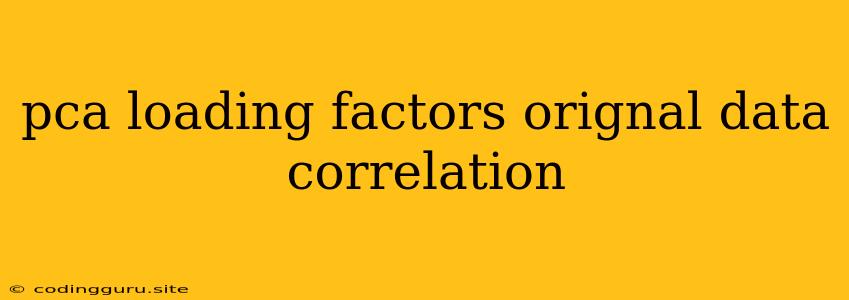Understanding Principal Component Analysis (PCA) Loadings and Their Relationship with Original Data Correlation
Principal Component Analysis (PCA) is a powerful dimensionality reduction technique used in various fields, including machine learning, data analysis, and statistics. It transforms a set of correlated variables into a set of uncorrelated variables called principal components. These components capture the maximum variance in the original data, allowing for data compression and visualization while preserving the most significant information.
But how do these principal components relate to the original data? This is where PCA loadings come into play.
What are PCA Loadings?
PCA loadings are coefficients that represent the contribution of each original variable to the respective principal component. They essentially tell us how much each original variable "loads" onto each principal component.
Think of it this way: If a variable has a high loading on a particular principal component, it means that variable is highly correlated with that component. Conversely, a low loading indicates a weak correlation.
Here's a simple analogy:
Imagine you have a dataset of student performance with variables like Math Score, Science Score, English Score, and Art Score. After applying PCA, you might find that the first principal component represents "Academic Performance" and the second represents "Artistic Ability."
Now, if the Math Score variable has a high loading on the "Academic Performance" component, it suggests that students who score high in Math generally also perform well in other academic subjects. On the other hand, if Art Score has a high loading on the "Artistic Ability" component, it suggests that students who excel in art tend to have a stronger artistic inclination.
Interpreting PCA Loadings: The Correlation Connection
The key takeaway is that PCA loadings are directly related to the correlation between original variables.
- High loadings: Indicate a strong correlation between the original variable and the corresponding principal component.
- Low loadings: Indicate a weak correlation between the original variable and the corresponding principal component.
By examining the loadings, we can understand which original variables contribute most to each principal component, providing insights into the relationships between variables and the underlying structure of the data.
Here are some ways to use PCA loadings:
- Variable selection: Identifying variables with high loadings on the most important principal components can help in selecting a smaller set of variables for further analysis.
- Data interpretation: Understanding the relationships between original variables and principal components can reveal hidden patterns and insights within the data.
- Feature engineering: PCA loadings can be used to create new features based on combinations of original variables, potentially leading to improved model performance.
A Simple Example:
Consider a dataset with three variables: Height, Weight, and Age. After performing PCA, we obtain two principal components. The loadings for each variable on these components might look like this:
| Variable | PC1 Loading | PC2 Loading |
|---|---|---|
| Height | 0.8 | 0.2 |
| Weight | 0.7 | -0.3 |
| Age | 0.1 | 0.9 |
From this table, we can observe:
- PC1: Height and Weight have high loadings on PC1, suggesting that these variables are strongly correlated and contribute significantly to the first principal component. This component might represent overall physical characteristics.
- PC2: Age has a high loading on PC2, while Height and Weight have low loadings, indicating a stronger correlation between age and PC2. This component could potentially represent the influence of age on the data.
Conclusion
PCA loadings provide valuable information about the relationship between original variables and the principal components derived from them. By understanding these relationships, we can gain deeper insights into the underlying structure of the data, perform variable selection, and create new features for improved data analysis and model building.
